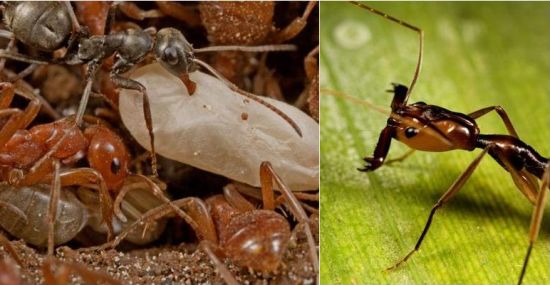
At the National Museum of Natural History, Smithsonian Institution, Smithsonian entomologist Ted Schultz coordinates an exhibition “Farmers, Warriors, Builders: The Hidden Life of Ants.” It will be a depiction of Mark Moffett’s photography of ants and is scheduled to run through October positively. Also, one of the attraction would be the unveiling of the painting of Edward O.Wilson for the National Portrait Gallery. The scientific community regards Moffett’s ant photography as a perpetual source of inspiration for eco-discoverers who hope to bridge the gap between the hidden and the obvious.
Check out the video and a slideshow after the jump:
The Hidden World explored:
First and foremost, I am a storyteller… the fact is, I believe life is all about telling stories. Some of my favorite stories are my own research discoveries. Because I pick stories from remote parts of the earth that often have not been told before, I have often used my wits to survive… eating scorpions, spiders, and grubs with the native peoples of five continents… ascending a tree to escape bull elephants… discovering an Aztec burial chamber populated with blind cave tarantulas… tracking down frogs so lethal, their touch can kill… using blowguns in defense against Colombian drug lords… accidentally sitting on a fer-de-lance, the deadliest snake of the Americas.
Moffett is an explorer in the truest sense. These exploits find an expression in the present exhibition that looks forward to let you see these ants through the eyes of photographer. You can perceive an ant’s point of view. There are ants performing their mundane chores, sustaining their existence, sheltering, attacking, hording and what not.
Here, in this video, Edward O.Wilson demonstrates how ants lay down the chemical trail:
Mark Moffett combines science and photography:
I’m not very good at this reality thing. But you don’t have to sit in a lab with a white coat clicking away at a machine all day to be a biologist.
Yep, I second him on this and still, it’s difficult to understand how a high school dropout developed such a keen insight into nature and natural phenomena. Coming of a not-so-academic background, Mark worked as a field assistant on research projects with biologists across Latin America. He developed a taste for macrophotography and produced a document on marauder ants. Since then, he has been touching newer heights in this unexplored field of study.
Image Credit: Smithsonian

